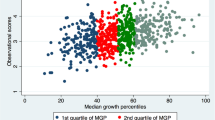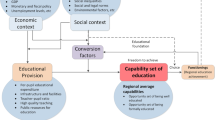Abstract
This study aims at evaluating the crucial effects of incorporating heterogeneities and hierarchies in the efficiency evaluation of higher education units through conducting multilevel frontier analysis. Using two sets of data on academic departments nested within faculties, and faculties within colleges of a comprehensive university in Iran, we simultaneously evaluate efficiency scores of departments, faculties, colleges, and the university. It has been shown that: (1) there is a great degree of heterogeneities among departments, faculties, and colleges of the university; (2) incorporating the heterogeneities changes efficiency scores which accordingly questions the accuracy of standard DEA and SFA efficiency estimates; (3) multilevel modelling helps to uncover huge differences in behavior and performance through decomposing overall efficiency scores into multiple measures of efficiency; and (4) departments, in comparison with faculties and colleges, play a more significant role in the overall performance of the university. Resource allocation policy implications of the findings were also discussed.
Similar content being viewed by others
Notes
Some studies tend to satisfy homogeneity of DMUs by selecting academic departments at a university or specialized departments across different universities. In this research, we show that there is a great degree of heterogeneities among academic departments of a university.
For a more detailed discussion on the evolved changes and heterogeneities initiated by government policies, see for example Rip and Kulati, (2015: 106–107).
Flegg et al. (2004: 232) also argue that the standard DEA has the disadvantage that it cannot distinguish between changes in relative efficiency brought about by movements towards or away from the efficiency frontier in a given year and shifts in this frontier over time.
The issue of heteroscedasticity and its effects has attracted some attention in analysis of efficiency. See, for example, Kumbhakar and Lovell (2000: 115).
Modified Iterated Generalized Least Squared (MIGLS) is another procedure to provide estimates of the technical efficiency using the IGLS residuals, exactly as in the CIGLS model. Nonetheless, due to space limitation, we confine our analysis to CIGLS.
Goldstein (1995: 22) states that when the residuals have normal distributions, the IGLS yields maximum likelihood estimates. Nonetheless, it would be interesting to compare the measures of technical efficiency derived from CIGLS estimators with those of maximum likelihood estimates which merits further research. The results would help to see if the claim made by Coelli et al. (2005: 245) that maximum likelihood estimators under some distributional assumptions about the error terms provide a better solution than COLS estimators, is held in the context of multilevel assessment of technical efficiency of HEUs (i.e., CIGLS estimators).
To examine the hypothesis that data used are dominated by a hierarchical structure, empirical analyses based on intra-unit correlation statistic were conducted. The results confirm the heterogeneities among departments, faculties, and colleges. Due to space limitations, the results are not reported here.
It is very interesting to see if the relationship between efficiency scores of the units of analysis at different levels should be negative or positive which merits further research.
References
Agasisti T, Bonomi F (2014) Benchmarking universities’ efficiency indicators in the presence of internal heterogeneity. Stud High Educ 39(7):1237–1255
Agasisti T, Gralka S (2019) The transient and persistent efficiency of Italian and German universities: A stochastic frontier analysis. Appl Econ 51(46):5012–5030
Ahn T, Charnes A, Cooper WW (1998) Some statistical and DEA evaluations of relative efficiencies of public and private institutions of higher learning. Socio-Econ Plan Sci 22(6):259–269
Askari R, Rafiei S, Ranjbar M, Pakdaman M, Sepase F (2019) Estimation of the efficiency of different academic departments using data envelopment analysis: A study in an Iranian medical university. J Med Educ Dev 14(1):56–65
Athanassopoulos AD, Shale E (1997) Assessing the comparative efficiency of higher education institutions in the UK by means of data envelopment analysis. Educ Econ 5(2):117–134
Battese GE, Rao DSP, O’Donnell CJ (2004) A metafrontier production function for estimation of technical efficiencies and technology gaps for firms operating under different technologies. J Prod Anal 21(1):91–103
Beasley J (1990) Comparing university departments. Omega 18:171–183
Carayannis EG, Goletsis Y, Grigoroudis E (2015) Multi-level multi-stage efficiency measurement: The case of innovation systems. Oper Res Int J 15:253–274
Castelli L, Pesenti R, Ukovich W (2004) DEA-like models for the efficiency evaluation of hierarchically structured units. Eur J Oper Res 154:465–476
Caudill SB, Ford JM, Gropper DM (1995) Frontier estimation and firm-specific inefficiency measures in the presence of heteroscedasticity. J Bus Econ Stat 13:105–111
Charnes A, Cooper WW, Rhodes E (1978) Measuring efficiency of decision making units. Eur J Oper Res 2:429–444
Charnes A, Clark T, Cooper WW, Golany B (1985) A developmental study of data envelopment analysis in measuring the efficiency of maintenance units in U. S. Air Forces. In: R. Thompson & R. M. Thrall (Eds.) Ann Oper Res 2:95–112
Coelli T, Rao PS, O’Donnell CJ, Battese GE (2005) An introduction to efficiency and productivity analysis. Second Edition, Springer
Cook WD, Chai D, Doyle J, Green R (1998) Hierarchies and groups in DEA. J Product Anal 10:177–198
Daghbashyan, Z (2011). The economic efficiency of Swedish higher education institutions. KTH Royal Institute of Technology, CESIS, Paper No. 245, March 2011
Doyle J, Green R (1994) Efficiency and cross-efficiency in DEA: Derivations, meanings, and uses. J Oper Res Soc 45(5):567–578
Erkoc TE (2015) Assessing the research performance in higher education with stochastic distance function approach. Int J Educ Econ Dev 6(4):366–380
Färe R (1991) Measuring Farrell efficiency for a firm with intermediate inputs. Acad Econ Pap 19(2):329–340
Flegg AT, Allen DO, Field K, Thurlow TW (2004) Measuring the efficiency of British universities: A multi-period data envelopment analysis. Educ Econ 12(3):231–249
Goldstein H (1995) Multilevel statistical models. Edward Arnold, London
Gralka, S (2018). Stochastic frontier analysis in higher education: A systematic review. CEPIE Working Paper, No. 05/18. Technische Universität Dresden, Faculty of Business and Economics
Greene W (2004) Distinguishing between heterogeneity and inefficiency: Stochastic frontier analysis of the World Health Organization’s panel data on national health care systems. Health Econ 13:959–980
Greene W (2005) Reconsidering heterogeneity in panel data estimators of the Stochastic Frontier Model. J Econom 126:269–303
Greene W (2008) The econometric approach to efficiency analysis. In: Fried Harold O, Knox Lovell CA, Schmidt Shelton S (eds) The measurement of productive efficiency and productivity growth. Oxford University Press, Inc., Oxford, p 92–250
Huang H-C (2004) Estimation of technical inefficiencies with heterogeneous technologies. J Product Anal 21:277–296
Johnes G (2013) Efficiency in higher education institutions revisited: A network approach. Econ Bull 33(4):2698–2706
Johnes J (2006) Measuring efficiency: A comparison of multilevel modelling and data envelopment analysis in the context of higher education. Bull Econ Res 58(2):75–104
Johnes J, Taylor J (1990) Performance indicators in higher education. SRHE and Open University Press, Buckingham
Johnes J, Johnes G (1995) Research funding and performance in U.K. University Departments of Economics: A frontier analysis. Econ Educ Rev 14(3):301–31
Kao C, Hung H-T (2008) Efficiency analysis of university departments: An empirical study. Omega 36:653–664
Kumbhakar SC, Lovell CAK (2000) Stochastic frontier analysis. Cambridge University Press, Cambridge
Lee BL, Worthington AC (2016) A network DEA quantity and quality-orientated production model: An application to Australian university research services. Omega 60:26–33
Lewisa HF, Sexton TR (2004) Network DEA: Efficiency analysis of organizations with complex internal structure. Comput Oper Res 31:1365–1410
Marschak J, Andrews WH (1994) Random simultaneous equations and the theory of production. Econometrica 12(3 and 4):143–205
Naderi A (2008) Comparative-efficiency evaluation of university education: An appropriate approach for methodological challenges of quality improvement. J Res Plan High Educ 47:19–51
Naderi A (2016) The application of production functions to Iranian higher education system. Int J Educ Econ Dev 7(1/2):53–78
Naderi A, Mace J (2003) Education and earnings: A multilevel analysis. Econ Educ Rev 22(2):43–56
Parmeter CF, Kumbhakar S (2014) Efficiency analysis: A primer on recent advances. November 5:2014. Mimeo
Rip A, Kulati T (2015) Multilevel dynamics in universities in changing research landscapes. In: Dorothea Jansen, Insa Pruisken (eds) The changing governance of higher education and research: Multilevel perspectives. Springer International Publishing, Switzerland, pp 105–116
Rogge N, Agasisti T, De Witte K (2017) Big data and the measurement of public organizations’ performance and efficiency: The state-of-the-art. Public Policy and Administration, 32, 1–19
Seiford LM (1996) Data envelopment analysis: The evolution of the state of the art (1978–1995). J Product Anal 7:99–137
Talluri S (2000) Data envelopment analysis: Models and extensions Decision Line, May, 8–11
Thanassoulis E, Portela MCS (2002) School outcomes: Sharing the responsibility between pupil and school. Educ Econ 10(2):183–207
Thanassoulis E, De Witte K, Johnes J, Johnes G, Karagiannis G, Portela CS (2016) Applications of data envelopment analysis in education. In J. Zhu (ed.). Data Envelopment Analysis: A Handbook of Empirical Studies and Applications. Springer, 367–438
Tone K, Tsutsui M (2009) Network DEA: A slacks-based measure approach. Eur J Oper Res Soc 197:243–252
Tsionas EG (2002) Stochastic frontier models with random coefficients. J Appl Econom 17(2):127–147
Viana RA, Arranz JM, García-Serrano C (2020) Efficiency of university education: A partial frontier analysis. Latin Am Econ Rev 29(1):1–16
Villano RA, Tran C-DTT (2019) Technical efficiency heterogeneity of tertiary institutions in Vietnam: A metafrontier directional technology approach. Technol Econ Dev Econ 25(6):1058–1080
Villano R, Mehrabi Boshrabadi H, Fleming E (2010) When is metafrontier analysis appropriate? An example of varietal differences in pistachio production in Iran. J Agri Sci Technol 12:379–389
Author information
Authors and Affiliations
Corresponding author
Ethics declarations
Conflict of interest
The authors declare no competing interests.
Additional information
Publisher’s note Springer Nature remains neutral with regard to jurisdictional claims in published maps and institutional affiliations.
Rights and permissions
About this article
Cite this article
Naderi, A. Efficiency measurement of higher education units using multilevel frontier analysis. J Prod Anal 57, 79–92 (2022). https://doi.org/10.1007/s11123-021-00621-0
Accepted:
Published:
Issue Date:
DOI: https://doi.org/10.1007/s11123-021-00621-0




